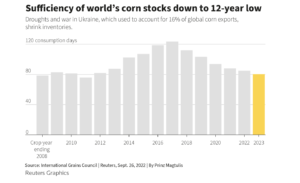Agriculture Secretary Brooke Rollins said on Tuesday that the Trump administration will announce a 'bridge payment' for farmers next week that is designed to provide short-term relief while longer trade…
Adverse Weather Brings “Shrinking” Harvests, and Tight Global Grain Inventories
Reuters writer Tom Polansek reported yesterday that, “The world is heading toward the tightest grain inventories in years despite the resumption of exports from Ukraine, as the shipments are too few and harvests from other major crop producers are smaller than initially expected, according to grain supply and crop forecast data.
“Poor weather in key agricultural regions from the United States to France and China is shrinking grain harvests and cutting inventories, heightening the risk of famine in some of the world’s poorest nations.
“Importers, food manufacturers and livestock producers had hoped crop availability would improve after war-torn Ukraine resumed shipments from Black Sea ports this summer and U.S. farmers planted large crops. But the United States, the world’s top corn producer, is now expected to harvest its smallest corn crop in three years. Drought also punished European harvests and is threatening South America’s upcoming planting season.”

Polansek pointed out that, “By the end of the 2022/23 crop year, the world’s buffer stocks of corn will be enough for just 80 days’ worth of consumption, down 28% from five years ago and the lowest level since 2010/11, according to figures compiled for Reuters by the International Grains Council, an intergovernmental organization.
That would be fewer days of corn stocks than the world had in 2012, when the last global food crisis spurred riots.
Meanwhile, Reuters writer Pavel Polityuk reported today that, “A total of 231 ships with 5.3 million tonnes of agricultural products on board have left Ukraine so far under a deal brokered by the United Nations and Turkey to unblock Ukrainian sea ports, the Ukrainian infrastructure ministry said on Tuesday.”
And Reuters writer Philip Blenkinsop reported yesterday that, “Ukraine on Monday urged the European Union to support its plans to make the emergency paths for grain exports through the bloc permanent, with investment in at least five border terminals and a pipeline through which sunflower oil would flow.
“Ukraine’s agriculture minister Mykola Solsky told EU counterparts and the European Commission his country needed financial support to reduce its reliance on Black Sea exports that Russia had blocked and could hinder again.”
In other production developments, Reuters writer Sybille de La Hamaide reported yesterday that, “The European Union’s crop monitoring service MARS on Monday raised its projections for Russia’s 2022 wheat crop to a new record high, but lowered its grain maize crop forecast to take account of hot and dry summer weather.
“In a report, MARS estimated the Russian wheat harvest at 95.0 million tonnes, up from 88.8 million seen in its previous estimate in June, and now 25% above last year.”
Also yesterday, Reuters writer Ana Mano reported that, “Brazilian farmers are sowing soybeans at a faster pace this season, according to estimates from two agribusiness consultancies on Monday.”
Mano explained that, “Safras & Mercado estimates 2% of the national soybean area has been planted so far for the 2022/2023 cycle, more than twice as much as last year’s 0.8% of the area and above the historical average of 0.8% for this point in the season.
“Consultancy AgRural estimates farmers had planted 1.5% of the soybean area in Brazil, compared with 1.3% for the same period last year.”
#Brazilian farmers had planted 1.5% of the 2022-23 #soybean projected area by Sep 22. Number-three producer Paraná remained the front-runner, but rains during this week are likely to slow down the progress in the state: https://t.co/VmIEyVr6c4. pic.twitter.com/uxrBuRii7V
— Daniele Siqueira (@siqueiradaniele) September 26, 2022
With respect to U.S. production, Reuters writer Naveen Thukral reported today that, “The U.S. Department of Agriculture said corn harvest was 12% complete as of Sunday, behind the average analyst estimate of 13% and the five-year average of 14%.
“The soybean harvest was 8% complete, lagging the average analyst estimate of 11% and the five-year average of 13%, the agency reported after the market closed on Monday.”
And Linda Qiu reported in today’s New York Times that, “…[T]echniques, known as regenerative or climate-smart agriculture, are a cornerstone of the Agriculture Department’s approach to addressing a warming planet…The Biden administration committed $22 billion this summer toward Agriculture Department programs using that approach, the largest federal investment to date in climate-smart practices. The funding makes good on a pledge from President Biden in his first week in office to encourage such practices in a sector that produces about 11 percent of greenhouse gas emissions nationwide.
“Mr. Biden has heralded the potential of these techniques to capture carbon dioxide from the atmosphere and store it as carbon in the soil, thereby reducing the effect of the planet-warming gases. However, scientists still have not determined just how much and for how long carbon can be sequestered and how to even measure any impact.”
Today’s article added that, “The bulk of the federal funding, about $19.5 billion from the Inflation Reduction Act that Mr. Biden signed last month, would shore up existing agricultural conservation programs that encourage climate-smart practices. The Agriculture Department announced in recent weeks that it would spend an additional $2.8 billion to enact and research climate-smart production on 20 million to 25 million acres of working lands.”





